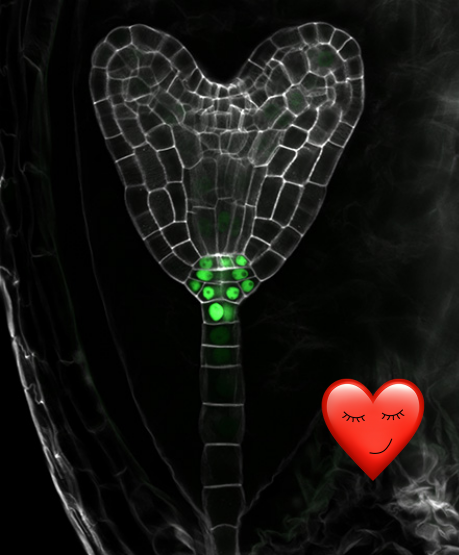
Who We Are, What We Do and... Why
As primary producers, plants are essential for sustaining ecosystems, regulating the climate, and supporting human life through food and oxygen production. As the global human population increases, agricultural production must expand substantially to meet future food demands. At the same time, climate change poses a serious threat to crop productivity by altering growth conditions, reducing yields, and impacting nutritional quality.
Successful crop production relies on efficient sexual reproduction in plants, encompassing processes such as flower development, pollination, fertilization, and ultimately seed formation. These developmental stages are tightly controlled by plant hormones, which act as key signaling molecules. Our research focuses on unraveling how internal (hormonal) and external (environmental) signals integrate to influence plant morphogenesis and seed formation.
 Auxin reporter expression (green) in the heart-stage embryo of Arabidopsis seeds
Auxin reporter expression (green) in the heart-stage embryo of Arabidopsis seeds
Using Arabidopsis thaliana as a model system, we aim to uncover the cellular and molecular mechanisms that regulate hormone dynamics during reproductive development. Our findings demonstrate that maternally produced auxin from the ovule integuments plays a critical role in supporting early embryo development in Arabidopsis [1]. Furthermore, in the context of high ambient temperature, transcriptomic analysis of pistils reveals molecular changes associated with reduced fertilization efficiency, including downregulation of auxin metabolism, upregulation of auxin signaling genes, and increased expression of pollen tube attractants [2]. We also investigate the roles of Auxin Response Factors and microRNAs in the regulation of plant somatic embryogenesis [3].
Our study on oilseed rape (Brassica napus) shows that high ambient temperatures accelerate embryonic development but lead to developmental defects, ultimately reducing viable seed yield. This yield reduction is attributed to lower fertilization rates, increased seed abortion and defective embryogenesis [4]. Transcriptomic analysis, complementing earlier phenotypic observations, highlights the roles of reactive oxygen species (ROS) response, seed photosynthesis, and hormonal regulation as critical factors in stress tolerance [5]. Additionally, we investigate how prolonged exposure to high temperatures impacts seed maturation and seed coat integrity.
 Secondary embryo development (arrow) in oilseed rape at high temperatures compared to normal embryo (left)
Secondary embryo development (arrow) in oilseed rape at high temperatures compared to normal embryo (left)
We also focus on developing improved plant transformation methods. We have established efficient hairy root transformation and regeneration protocols for several cruciferous species, including Asperuginoides axillaris, A. thaliana, B. napus, and Cardamine hirsuta [6, 7]. Using this transformation system, we are developing hormonal reporters across Brassicaceae species. Furthermore, the hairy root system is not limited to Brassicaceae ˗ we successfully generated composite plants with wild-type shoots and transgenic hairy roots in almond (Prunus dulcis, Rosaceae), a species traditionally considered recalcitrant to transformation [8]. Additionally, we achieved successful genome editing via CRISPR in both oilseed rape and almond using hairy root tissue cultures [8, 9].
Regarding the newly adopted provisional agreement on new genomic techniques (NGTs) in the EU, our new transformation methods, coupled with advanced CRISPR-based approaches enabling precise and targeted mutagenesis, appear to be highly significant. Under the agreement, so-called NGT-1 plants, which contain small and targeted genomic modifications, will be treated in the same manner as conventional plants.


As part of collaborative projects, we provide transformation services for oilseed rape using our optimized protocols, which are also suitable for CRISPR-mediated genome editing.
We are also open to exploring transformation and regeneration approaches for other species and plant families, tailored to the specific needs and research goals of our collaborators.
Reach out to us, as we are happy to discuss new ideas and potential collaborations.


